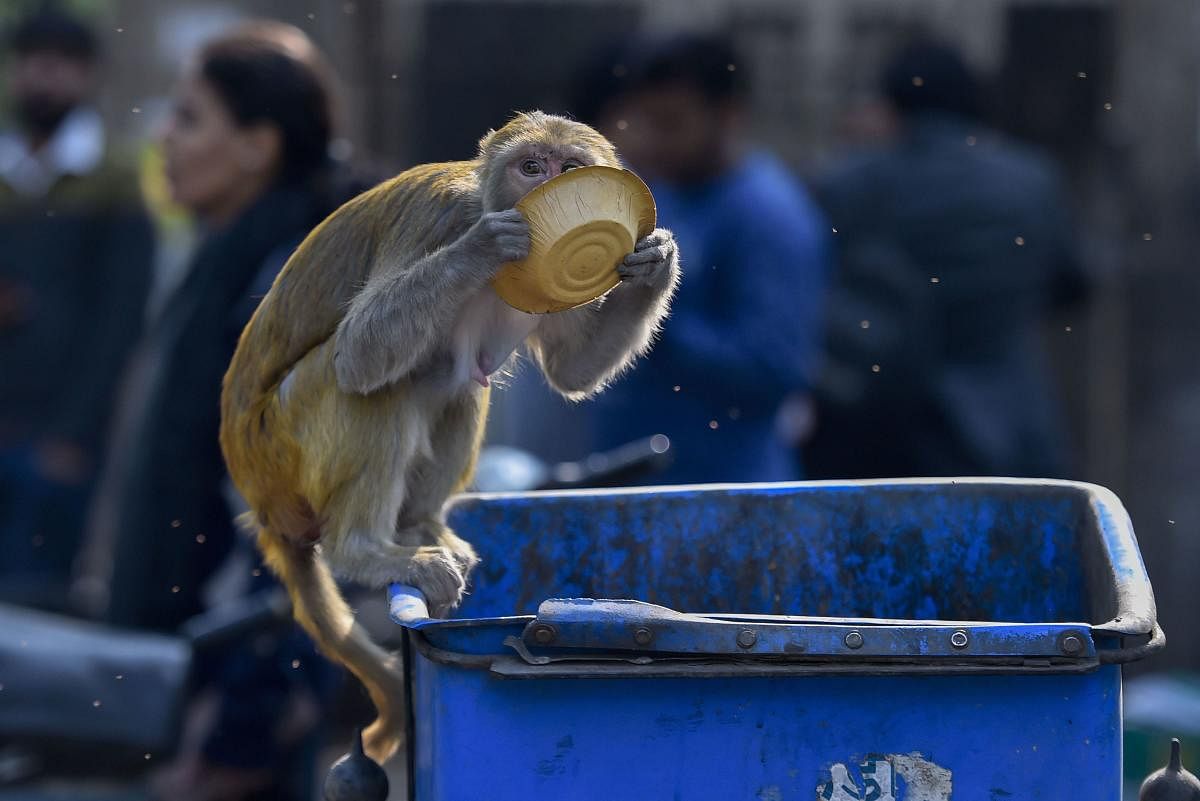Science says we evolved from monkeys. Still just as our population is rising and we go about monkeying in their world, the simian population is also rising in the country, and they have begun to monkey about in our world.
Farmers in the hilly Western Ghats in Karnataka, for instance, are so worried by monkey trouble that they recently met Chief Minister BS Yediyurappa about it. He, in turn, assured them that he would establish monkey parks to keep them off the farms. But the monkey menace is not limited to Karnataka, the issue has echoed even in parliament. Monkeys have not spared even Lutyens’ Delhi, the supposed symbol of security, comfort and urban sophistication. No more does the monkey problem remain a man-animal conflict of the countryside. Rather, it is a pan-India social problem.
Primatologists tell us that there are more than a dozen species of primates found across India. The bonnet macaque, rhesus macaque and grey langur are more widely distributed among them. Troops, 50-60 strong, of the common monkey or rhesus macaque (Macaca mulatta) are often found jumping up and down searching for food in most urban and semi-urban areas in northern India. They like shrubs, deciduous forests and grasslands, too.
The bonnet macaque (Macaca radiata), which move in groups of 30-45, are commonly seen in southern India, having huge presence in the varied types of forests of Western Ghats and Eastern Ghats. The grey or Hanuman langur (Semnopithecus entellus) is the third most common monkey found across the subcontinent.
These are all basically social animals living in trees but can adapt to a variety of habitats. It is this natural instinct that has helped them in expanding their territory, including into human settlements. While elephant raids or panther strikes are restricted to certain pockets, monkey trouble has spread all over the country in epic proportions. Field research shows that it is causing extensive damage to agriculture, which is already facing low productivity due to extreme weather events like draughts and floods. Farmers are often unable to sow their desired crops or properly harvest their produce due to the monkey menace. In Karnataka alone, for instance, government agencies say that crops worth over Rs 300 crore were lost last year and it is thus one of the reasons for farmers’ distress in the countryside. Meanwhile, urban dwellers, too, struggle as monkeys routinely attack kids or damage property.
Ecological studies in the Western Ghats in Karnataka reveal the multiple reasons behind the monkey menace. Of course, it is essentially the result of loss of wildlife habitats. Growing urbanization, expanding agriculture and industrialization in and around forests and grasslands are displacing animals from their own habitats. Waterholes like streams and ponds are drying up. The lack of food and water initially force them to invade nearby villages. In time, doing so becomes their habit!
There are other reasons, too. Increased food production, starting from the Green Revolution era, gave more access to sugar and protein-rich agro-produce to herbivorous wildlife. Primatologists say that monkeys have found this source of food attractive and have become habitual crop-raiders. They are attaining higher life spans, too, due to assured food and safety in human spaces. They are left with more time now for procreation and they also have better chances of survival.
What’s more, while the decreasing population of big predators have spared monkeys from getting killed in the wild, they are also worshipped as Hanuman in human society! It is truly an ecological disorder now, which is growing into a large-scale economic crisis.
The solution for this evidently complex issue may lie in multiple strategies. Developing green corridors around human settlements and growing more fruit-yielding trees in forests could certainly help in the long term. Foraging ecology studies show that banyan, mango, tamarind, neem, pongamia, jamun and such trees would keep them hooked to their wild habitats.
As monkeys monitor their neighbour’s movements and surroundings while discovering food sources, promoting traditional techniques of scaring them would be effective. Placing scarecrows, spreading boneless dry fish with chilli powder, employing ultrasonic guns or sound systems playing sounds of a tiger’s roar or of dogs barking would be useful tricks. There is also an urgent need to look at judicious application of culling and sterilization principles to control their reproduction rate.
All these approaches need to be properly guided through institutional mechanisms and community initiatives. Monkey species must be brought under the Union list so that a national programme could be initiated to monitor and control their population. Instead of such a comprehensive approach, however, forest departments have been doing unscientific and forcible translocations.
Currently, the politically appealing idea of establishing ‘monkey parks’ is gaining sudden currency, without its proponents realising its ecological damage and economic cost. Research has shown that wild monkeys are prone to multiple diseases in captivity and those diseases could spread to other wildlife. It has happened, in fact, in the case of Kyasanoor Forest Disease (KFD or Monkey Disease). Thousands of forest dwellers got affected and several died due to this tick-borne viral haemorrhagic fever as recently as last summer in Shivamogga district, the heart of Western Ghats in Karnataka. Establishing monkey parks, that too in or around forest regions, may therefore bring more problems than solace!
This issue must be seen as an initial stumble on the way to resolving larger man–animal conflicts arising out of the current development paradigm. Only timely and right interventions could help prevent a larger ecological disaster in the future. Designing a holistic approach is the need of the hour. We cannot afford to monkey around with this issue.
(The writer is Director, Centre for Conservation Biology & Sustainable Development, Sirsi)
